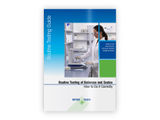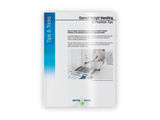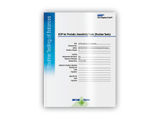To use all functions of this page, please activate cookies in your browser.
my.chemeurope.com
With an accout for my.chemeurope.com you can always see everything at a glance – and you can configure your own website and individual newsletter.
- My watch list
- My saved searches
- My saved topics
- My newsletter
Lead(II) chloride
Lead(II) chloride has the formula PbCl2. It is also known as lead chloride, lead dichloride, and plumbous chloride. PbCl2 is one of the most important lead-based reagents. PbCl2 also occurs naturally in the form of the mineral cotunnite. Additional recommended knowledge
SolubilityThe solubility of PbCl2 in water is low (9.9 g/L at 20 °C) and for practical purposes it is considered insoluble. Its solubility-product constant (Ksp) at 25 °C (298 K) is 1.6 x 10-5. It is one of only three commonly insoluble chlorides, the other two being silver chloride (AgCl) with Ksp = 1.8 x 10-10 and mercury (I) chloride (Hg2Cl2) with Ksp = 1.3 x 10-18.[1] ReactionsPrecipitation from aqueous solutionLead(II) chloride precipitates from solution upon addition of chloride sources (HCl, NaCl, KCl) to aqueous solutions of lead(II) compounds such as Pb(NO3)2.
Soluble chloro complexesAddition of chloride ions to a suspension of PbCl2 gives rise to soluble complex ions. In these reactions the additional chloride (or other ligands) break up the chloride bridges that comprise the polymeric framework of solid PbCl2(s).
[PbCl3]-(aq) is isoelectronic with PCl3.
Organometallic derivativesLead(II) chloride is the main precursor for organometallic derivatives of lead. The usual alkylating agents are employed, including grignard reagents and organolithium compounds:
Notice how these reactions produce derivatives that are more similar to organosilicon compounds, i.e. that Pb(II) tends to disproportionate upon alkylation. Conversion to oxidesPbCl2 reacts with molten NaNO2 to give PbO:
PbCl2 is also used to prepare ceramics by cation replacement reactions:
SynthesisPbCl2 can be synthesized by several methods as discussed above, that is, by precipitation as a solid by reaction of an aqueous Pb(II) salts with a soluble chloride salts. An interesting reaction involves treatment of Pb(IV) oxide with HCl:
Notice that lead(IV) chloride is not formed as it is unstable with respect to loss of Cl2. PbCl2(s) also forms by the action of chlorine gas on Pb metal:
Uses of lead(II) chloride
StructureIn solid PbCl2, each lead is coordinated by 9 chloride ions - 6 lie at the apices of a trigonal prism and 3 lie beyond the centers of each prism face. PbCl2 forms white orthorhombic needles. Vaporized PbCl2 molecules have a bent structure with the Cl-Pb-Cl angle being 98° and each Pb-Cl bond distance being 2.44Å.[14] PbCl2 is emitted from internal combustion engines that use ethylene chloride-tetraethyllead additives for antiknock purposes. CotunnitePbCl2 occurs naturally in the form of the mineral cotunnite. It is colorless, white, yellow, or green with a density of 5.3-5.8 g/cm3. The hardness on the Mohs scale is 1.5-2. The crystal structure is orthorhombic dipyramidal and the point group is 2/m 2/m 2/m. Each Pb has a coordination number of 9. The composition is 74.50% Pb and 25.50% Cl. Cotunnite occurs near volcanoes: Vesuvius, Italy; Tarapaca, Chile; and Tolbachik, Russia.[15] ToxicityLike other lead containing compounds, exposure to PbCl2 may cause lead poisoning. References
Categories: Lead compounds | Chlorides | Metal halides | IARC Group 2A carcinogens |
|||||||||||||||||||||||||||||||||||||||||||||||||||||||||||||
| This article is licensed under the GNU Free Documentation License. It uses material from the Wikipedia article "Lead(II)_chloride". A list of authors is available in Wikipedia. | |||||||||||||||||||||||||||||||||||||||||||||||||||||||||||||
- Shedding a new light on optical trapping and tweezing - A new device for manipulating and moving tiny objects with light
- Smoke Detector “Sniffs out” Causes of Fire - Alarm Before There Is Even a Fire
- Pop_pop_boat
- New diamond structures produce bright luminescence - Use in quantum cryotography and biomarkers applications
- A better alternative to gasoline - Cost-saving measure to upgrade ethanol to butanol







